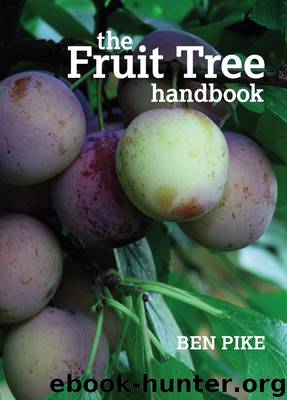The Fruit Tree Handbook by Ben Pike

Author:Ben Pike
Language: eng
Format: epub
Publisher: UIT Cambridge Ltd.
Crab apple blossom is not only beautiful but is also a valuable source of pollen to pollinate apple trees.
Some apples are triploids, meaning that they have no viable pollen of their own (see Chapter 3, page 40). This means that two other apple varieties are needed – to pollinate the triploid, and to pollinate each other.
Planting a crab apple that flowers over a long period (as most do) can be a valuable aid to successful pollination.
Fruit thinning
It is preferable to thin heavy crops of apples. This will produce larger fruits of better quality. It also minimises the risk of biennial cropping and branches breaking from the strain of heavy crops. Thinning is best carried out in mid-July, once the June Drop (see page 41) has taken place.
Dessert apples can be thinned to leave fruits 10-15cm (4-6") apart, with one to two fruits per cluster. Cooking apples, because of their larger size, should be thinned to leave fruits 15-20cm (6-8") apart, with just one fruit per cluster.
Where a cluster of fruits has developed, there will often be a slightly misshapen fruit in the centre of the cluster; this is known as the king fruit and should be removed. Also thin out any blemished or small fruits, leaving the large healthy fruits to grow on. Thinning can be carried out with scissors or fingers and thumb.
Young trees should not be allowed to bear a heavy crop, because the tree’s energy will be diverted from producing strong growth towards producing fruit. In extreme cases this can lead to the tree becoming stunted. It is best to remove all fruit in the first two years.
Apple varieties
Choosing apple varieties can be a bewildering task. There are over 2,000 varieties still grown in Britain, so narrowing it down to the varieties that are right for you can be time-consuming. However, it is worth taking the time at this stage, because the choice of variety is crucial to later success. It is tempting to pick a variety that you buy from the supermarket, thinking that it will grow well in your garden, but common supermarket apples do not necessarily make good garden apples. Gala, for example, is very susceptible to scab, while Braeburn often fails to ripen properly in an English summer, except in the most favoured locations.
SPUR-BEARERS AND TIP-BEARERS
Most (about 75 per cent) of apple trees are spur-bearers: they produce most of their fruit on knobbly growths – spurs – that form on two-year-old or older wood. With practice this type of tree can be recognised by the presence of the knobbly spurs, which are easily spotted in winter.
Tip-bearers, on the other hand, produce the majority of their fruit from buds on the ends of shoots that were produced in the previous year. Grenadier and Beauty of Bath are examples of tip-bearers. See Diagrams 28 and 30 on pages 188 and 189 for an illustration of the distinction.
A quick internet search or look in a reference book will tell you whether a given variety is a tip-bearer or a spur-bearer.
Download
This site does not store any files on its server. We only index and link to content provided by other sites. Please contact the content providers to delete copyright contents if any and email us, we'll remove relevant links or contents immediately.
Turbulence by E. J. Noyes(7941)
The Thirst by Nesbo Jo(6832)
Gerald's Game by Stephen King(4584)
Be in a Treehouse by Pete Nelson(3952)
Marijuana Grower's Handbook by Ed Rosenthal(3623)
The Sprouting Book by Ann Wigmore(3543)
The Red Files by Lee Winter(3368)
The Remains of the Day by Kazuo Ishiguro(3295)
Sharp Objects: A Novel by Gillian Flynn(2958)
Christian (The Protectors Book 1) by L. Ann Marie(2654)
Organic Mushroom Farming and Mycoremediation by Tradd Cotter(2631)
The Culinary Herbal by Susan Belsinger(2433)
Stone Building by Kevin Gardner(2353)
The Starter Garden Handbook by Alice Mary Alvrez(2285)
Lilac Girls by Martha Hall Kelly(2258)
The Unlikely Pilgrimage of Harold Fry by Rachel Joyce(2221)
The Lean Farm Guide to Growing Vegetables: More In-Depth Lean Techniques for Efficient Organic Production by Ben Hartman(2096)
Urban Farming by Thomas Fox(2061)
Backyard Woodland by Josh VanBrakle(1895)
